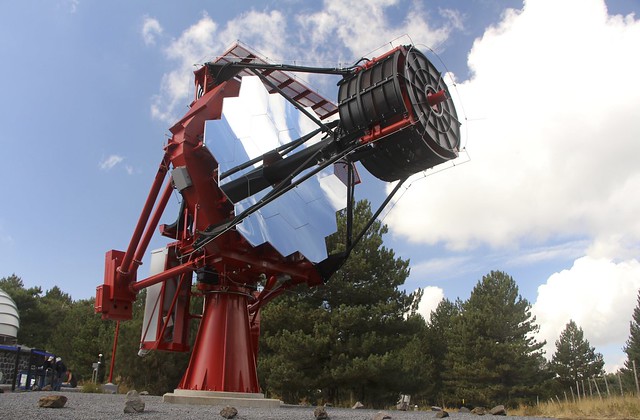
Crab Nebula detected with ASTRI-Horn Cherenkov Telescope
ASTRI-Horn is the first Cherenkov telescope in dual-mirror configuration to detect the Crab Nebula at TeV energies:

The ASTRI-Horn prototype telescope is located at the observing station of the INAF Astrophysical Observatory of Catania, in Serra La Nave, on Etna, where it was installed in 2014. The primary tassellated mirror has a diameter of 4 meters and the secondary monolithic mirror is 1.8 meters in diameter. Credit: CTA collaboration
Exactly 30 years after the first historical observation of Crab nebula at TeV energies, which opened the era of TeV astronomy with the Imaging Atmospheric Cherenkov Technique (IACT), another advancement in IACT technology has been achieved. The ASTRI-Horn Cherenkov Telescope, based on the innovative Schwarzschild-Couder dual-mirror configuration and equipped with an innovative camera, has detected the Crab Nebula at TeV energies for the first time, proving the viability of this technology.
This Cherenkov telescope, named ASTRI-Horn (in honor of Guido Horn d’Arturo an Italian astronomer who first proposed in the past century the technology of tessellated mirrors for astronomy), is adopting a wide (10°x10°) field Schwarzschild-Couder dual-mirror optical configuration and is equipped with a specifically designed, innovative Silicon photo-multiplier (SiPM) camera managed by very fast read-out electronics.
The observations of the Crab Nebula were carried out between December 2018 and January 2019, during the ASTRI-Horn telescope verification phase, for a total observation time of about 29 hours, divided in on- and off-axis source exposure. The camera system was still undergoing assessment, and its functionality was not fully exploited. Moreover, owing to recent eruptions of the Etna Volcano, the mirror reflection efficiency was partially reduced. In spite of such camera and mirrors limitations, observations yielded the detection of the Crab Nebula with a statistical significance of 5.4s above an energy threshold of about 3.5 TeV, definitively probing the new technologies and opening a new era for IACT.
“The result obtained by ASTRI is an important milestone for the IACT technologies. It is demonstrating that the dual mirror configuration, firstly proposed by the great German Astrophysicist Karl Schwarzschild more than a century ago, is performing well. It is now possible to achieve a very large field-of-view with a much more compact Cherenkov telescope design, easily observing very energetic cosmic gamma-rays up to a few hundreds of TeV” says Giovanni Pareschi, astronomer at the INAF-Milano and principal investigator of the ASTRI project.
The full press release is available here: https://www.cta-observatory.org/astri-detects-crab-at-tev-energies/
Contacts:
Giovanni Pareschi
INAF-Osservatorio Astronomico di Brera – ASTRI Princilpal
giovanni.pareschi@inaf.it
Megan Grunewald
CTAO Outreach and Communications Officer
megan.grunewald@cta-observatory.org



